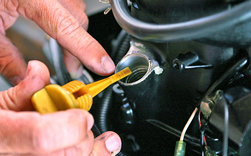
Maintenance is the key to a long, trouble-free relationship with your outboard motor. The golden rule is to keep the motor clean always. After each trip take time to spray thoroughly with a water repellent, rust preventative spray. Your owner’s manual may tell you the motor is treated with corrosion preventatives but the extra care will still pay dividends. While hosing the outside of the motor with fresh water removes a good deal of the salt spray, it is better to flush out the cooling system by running the motor immersed to usual operating level in a tank, drum, or suitable flushing attachment of fresh water.
To carry and store.
If your outboard must be carried and stored on its side, it is essential that the power head (the upper third) of the motor is higher than the leg or gearbox section. If not, rusting can result from water still inside the motor.
The motor must be turned over’ once a week. This is done by simply pulling the starting cord as if you intended to start the motor up. The aim is to alter the position of the pistons and impeller in the water pump. This small piece of attention should keep your motor ready to go even if stored for long periods.
Servicing.
Most owner’s manuals recommend having new motors serviced professionally three times the first year, after 3, 6 and 12 months’ use or after 20, 50 and 100 hours. After that, once or twice a year is enough if you look after it properly yourself in between services.
Spark plugs.
Spark plugs should be removed and checked once a fortnight. Look for cracked or damaged insulation. Clean plugs with petrol and steel brush and adjust spark gap to the manufacturer’s specifications. Leave parts clean and dry, and then rub a little graphite grease on the threads before refitting to the cylinder head. Keep a spare set of spark plugs handy.
Greasing the motor.
A useful tool for a boat owner is a grease gun, a simple gun-shaped attachment which screws into a tube of waterproof engine grease. The first supply can be purchased complete then refills obtained to fit the gun. The shape of the tool makes it easy for the grease to thoroughly penetrate important areas such as the swivel parts, throttle connection and vertical shaft. While doing this job, you should also remove the propeller and check behind it. If using the boat frequently do this once a month as fishing lines and debris can lodge around the prop shaft. After removing any debris, grease shaft and replace the propeller.
Changing the oil.
To change the oil in your outboard, locate the two access points at top and bottom. Remove the screws from both holes. The oil is sold in a squeeze container to suit your motor’s H P. With the screws still out, insert the bottle nozzle into the lower hole and pump oil in until it seeps out of the top hole. Keep the nozzle in place while you replace the upper screw then remove bottle and replace lower screw, tightening it. Finally, remove the upper screw again and top up with oil until it seeps out. These simple actions prevent any air getting into the gearbox. For normal running, keep the oil level topped up through the top screw only, adding oil until it seeps out and replacing screw.
The petrol tank.
Most outboard motors use two-stroke fuel, that is, the oil and petrol are mixed together and transferred to the engine. In a car they are added independently and can last for several thousand miles before needing to be replaced. In an outboard, the additives usually found in car oils build up around the plugs, so it is necessary to buy special two-stroke fuel for your outboard. It is advisable to mix your own petrol oil mix. The manufacturer usually recommends the proportions of petrol to oil. By doing this you can judge the quantity of fuel required and ensure the fuel stays fresh in the tanks. It is very important to use fresh fuel in your tanks.
Materials you’ll need:
- Owner’s manual for your outboard motor (keep it safe and handy)
- Water repellent, rust preventative spray such as C.R.C.I WD40 or RP7
- Tank, drum, or recommended flushing unit
- Spare set spark plugs
- Graphite grease
- Outboard motor oil in squeeze bottle.
Tools you’ll need:
- Steel brush
- Grease gun and refills


